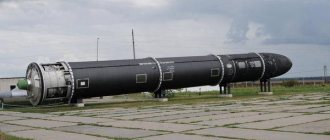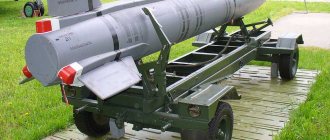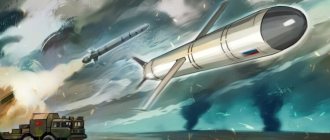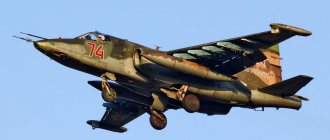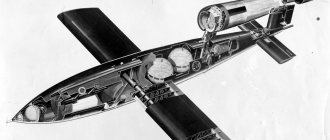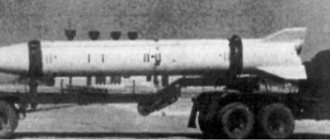Kh-22 cruise missile
In the mid-nineties, the operation of Tu-22K missile-carrying bombers ended. These honored aircraft were written off and disposed of, and the units where they served continued to use newer Tu-22M bombers of several modifications. Tu-22K were withdrawn from service due to technical and obsolescence. The characteristics of these aircraft and their electronic equipment no longer suited the military. In addition, missile carriers of this model ran out of service life in the early nineties, which led to the massive decommissioning of equipment. The Tu-22K bomber was created as a carrier aircraft for the K-22 missile system with the Kh-22 missile. The characteristics and modernization potential of this complex turned out to be so high that in the mid-nineties it was considered suitable for further operation. Moreover, Kh-22 missiles of several modifications are still included in the range of weapons of the Tu-22M3 bomber.
The development of the new K-22 missile system with the Kh-22 cruise missile began in 1958 in accordance with a resolution of the USSR Council of Ministers. The development of the rocket and equipment for the carrier aircraft was entrusted to the design team of OKB-155-1 (Dubninsk branch of OKB-155) under the leadership of A.Ya. Birch forest. At that time he reported to the company A.I. Mikoyan, but in 1965 it was made an independent organization. Nowadays the Dubna OKB-155-1 is known as the Raduga MKB. In accordance with the requirements of the military, it was necessary to create an air-launched cruise missile designed to destroy both point and area targets at a range of at least 300 kilometers. It was necessary to ensure the rocket's flight speed was at least 2500-3000 km/h. The ammunition carrier was to be a Tu-22 aircraft with updated equipment.
Initially, two versions of the new missile were developed with different guidance systems corresponding to the tasks performed. Design, power plant, warhead, etc. was supposed to be unified. It is noteworthy that this approach to the creation of the project made it possible to subsequently develop several modifications of the rocket, which differed from each other in various components and assemblies, warheads, and also had different characteristics.
The requirements for the project determined the aerodynamic appearance of the new rocket. Both versions of the X-22 missile had a cylindrical body 11.3 meters long and 94 cm in diameter. In the middle part, a mid-mounted triangular wing of low aspect ratio and high sweep with a span of 2.4 meters was attached to the body. The tail consisted of two fins, on top and bottom of the body, as well as two stabilizers on the sides. In the first versions of the project, it was proposed to install the lower fin on the rocket after it was suspended from the aircraft. Later it was made folding. The upper one, in turn, was stationary and, when suspended under the fuselage of the aircraft, was located in the niche of the cargo compartment.
To ensure high flight speed, the X-22 rocket received a two-chamber liquid engine R201-300. The combustion chambers and engine nozzles have different sizes: the larger one (upper) was intended to accelerate the rocket and provided a thrust of about 83 kN, and the smaller one (lower) was responsible for cruising flight with a thrust of about 6 kN. The engine used provided high flight performance. During several test launches, the rocket's speed exceeded 3,600 km/h.
The launch weight of the first modifications of the X-22 rocket was 5.7 tons. The supply of fuel and oxidizer was 3 tons, from 600 to 1000 kilograms of starting weight fell on the warhead, depending on its type. The Kh-22 missile with target homing could carry a high-explosive fragmentation warhead, cumulative or nuclear, with an explosion power of 200-350 kt (according to various sources). The area-firing version was equipped exclusively with a nuclear warhead, which compensated for its low accuracy.
The missile version, designed to attack point targets, was equipped with an active radar homing head (GOS). Its important feature was the capture of the target before detachment from the carrier aircraft. This modification of the missile was designated Kh-22PG. The second version, with the index X-22PSI, received an autonomous path calculator based on an inertial navigation system and Doppler meters.
After launch, both versions of the X-22 rocket operated independently, without any assistance from the carrier aircraft. Immediately after uncoupling from the beam holder, the fuel components should have ignited and the engine acceleration chamber should have started. After gaining speed M = 3.4 and an altitude of 22.5 km, the acceleration chamber was turned off and the work of the main chamber began. The active radar seeker of the Kh-22PG missile could find cruiser-type targets at a distance of up to 250-270 kilometers. Automatic guidance monitored the movement of the target relative to the missile in the horizontal and vertical planes. When the target shifted horizontally, commands were issued to the steering wheels. At a distance of about 60 km from the target, the missile went into a dive at an angle of 30° to the horizon, constantly adjusting its flight path.
The Kh-22PSI missile guidance system worked differently. Doppler meters constantly received information about the rocket's motion vector. This information and data from the inertial navigation system were fed to the computer. The latter processed all signals and issued commands to the steering gears.
In 1962, Plant No. 256 built the first rockets of the new model. Missile tests turned out to be complex and lengthy: problems regularly arose with various components of the products, from guidance systems to the engine. In particular, the P201-300 engine used toxic fuel, which is why technicians had to work in combined arms protective kits. At the same time, the new model rockets needed to be refueled immediately before the suspension on the aircraft, which complicated testing and further operation.
Due to all the problems and shortcomings, the Kh-22PG missile passed state tests only in 1967. The K-22 missile system consisted of the Kh-22 missile itself and the Tu-22K aircraft with a set of special equipment. It is worth noting that the “PN” radar station, used on the Tu-22K missile carriers, provided a launch range of no more than 300-310 kilometers. Subsequently, the use of new radars made it possible to increase the target detection distance and, as a result, the launch range. The development of a missile designed to destroy area targets was even more complex and time-consuming. It was adopted only in 1971.
Projections of the X-22 rocket
Despite all the operational difficulties and shortcomings, the X-22 family of missiles had fairly high performance. A flight speed of over 3000-3500 km/h made it possible to overcome any air defense systems of that time, and thanks to autonomous guidance systems and a flight range of about 300 kilometers, the risk for the carrier aircraft was reduced. Tests have shown that high-explosive fragmentation or cumulative warheads are capable of causing serious damage even to large and well-protected ships. Thus, after being hit by a missile flying at a speed of about 800 m/s, a hole with an area of up to 22 square meters remained in the side of the target ship. m, and the cumulative jet hit internal structures to a depth of 12 meters. When attacking ground targets, the warhead could destroy a factory workshop or a railway bridge.
The first carrier of the Kh-22 missiles was the Tu-22K bomber. The first few aircraft of this model were converted from serial Tu-22s, and construction of the new model began in 1965. The Tu-22K bomber received a PN radar station and a number of auxiliary equipment. The plane carried only one missile, semi-submerged in a modified cargo compartment.
In 1962, OKB-155-1 employees in Dubna began work on a version of the Kh-22 missile with a passive radar seeker. This ammunition was intended to destroy ground-based radars and enemy ships. The development of a new type of homing head turned out to be quite difficult. Because of this, work on the Kh-22P project was delayed and testing of the new rocket began only in the seventies. In 1976, the Kh-22P missile was put into service. In addition to the passive radar homing head, it was distinguished from other missiles in the family by a smaller warhead. According to some reports, the dimensions of the electronic equipment forced the payload to be reduced. Flight characteristics remained at the same level.
Guidance diagram of the Kh-22 missile 1. Target acquisition by the carrier's radar and the missile's ARGSN. Start and release. 2. Unlocking the rudders and starting the rocket engine. 3. Acceleration and climb. 4. Flight at a cruising altitude of 22500m, autopilot control along 3 axes and according to the seeker (course and range). The engine is in speed control mode. 5. For the Kh-22N rocket - flight at one of the specified marching altitudes in the range from 12000 to 22000m. Control - programmable autopilot and ARPGSN. 6. Turn off the engine and transfer the rocket into a dive at an angle of 30° after reaching a certain deflection angle of the seeker beam. 7. Detonation of a warhead according to seeker data or upon contact with a target.
In 1974, two cruise missiles of the X-22 family were immediately adopted. They differed from previous ammunition by a modified engine and a slightly modified design. The applied innovations made it possible to increase the maximum flight speed to 4000 kilometers per hour. At the same time, three similar missiles were being developed: the Kh-22MA with an active radar seeker, the Kh-22MP with a passive radar seeker, and the Kh-22M, designed to attack area targets. It should be noted that the Kh-22M missile was finalized after other developments with the letter “M” and was put into service only in 1976. The latest modifications of the X-22 missile were the X-22N and X-22NA, equipped with an inertial navigation system with route correction in accordance with terrain data.
In the seventies, the Kh-22B missile (“B” - ballistic) was also developed. At the final stage of the flight, this product was supposed to gain altitude and fly along a ballistic trajectory. Calculations and tests of prototypes have shown that in a dive from a height of about 70 km, the rocket will be able to accelerate to a speed of the order of M = 6. Due to the complexity of creating a heat-resistant body and components, the Kh-22B missile was not accepted for service, but developments from this project were later used to create experimental and combat missile systems.
A characteristic feature of all X-22 missiles put into service in the mid-seventies were new homing heads. They provided significantly greater accuracy. Thus, the probable circular deviation of the Kh-22N cruise missile did not exceed several tens of meters, and the Kh-22MA with an active radar seeker could with a high probability hit cruiser-type targets. In addition, in later modifications of the X-22, ampoule fuel refueling was introduced, which greatly simplified the operation of these missiles.
The main target of the K-22 missile system based on Tu-22K aircraft was naval groups of a potential enemy, primarily aircraft carriers. Attacks on enemy ships could be carried out using several methods. Depending on the situation, Tu-22K missile carriers could launch missiles from one direction or from several. In addition, it was planned to distribute missile carriers into several groups with the launch of missiles in one or two waves. The operating features of the active radar homing head of the X-22 cruise missiles, namely operation at a single frequency, led to the emergence of an interesting proposal regarding combat use. Since the missile attack could be thwarted by electronic warfare, it was proposed to use products with an inertial guidance system and a nuclear warhead in the first wave. It was assumed that the explosion of such a missile would damage or destroy the electronic equipment of enemy ships and allow the second wave of missiles to reach the target without problems.
The Tu-22K missile-carrying bombers, adapted for the use of Kh-22 family missiles, had fairly high characteristics for their time, but were not without shortcomings. First of all, complaints were caused by the small ammunition load - only one cruise missile. In the first half of the seventies, the Tu-95 aircraft was modified to use new cruise missiles. Its modification Tu-95K-22 could carry two missiles under the wing or one under the fuselage, in a semi-recessed position. The use of a long-range bomber as a carrier made it possible to significantly increase the combat radius of the entire complex.
In 1974, tests of the K-22M missile system began, in which the carrier aircraft was the newest Tu-22M2 bomber. Subsequently, the equipment of the complex was modified for Tu-22M3 aircraft. The new bombers, like the Tu-95K-22, had a cargo compartment in the fuselage designed to carry one X-22 missile in a semi-recessed position, and two suspension units under the wing. The K-22M missile system was adopted by the Air Force in 1981.
Tu-22M3
As part of the K-22 project, several cruise missiles for different purposes with various equipment were created. Several types of long-range bombers were used as carriers of these missiles. Over the four and a half decades that have passed since the K-22 complex was put into service, most of the carrier aircraft have become obsolete. The Tu-22K and Tu-95K-22 aircraft were withdrawn from service and disposed of, but the Kh-22 family of missiles are still used by the Russian Air Force. The only carrier of these missiles at the moment is the Tu-22M3 bomber.
According to various sources, over the years of mass production, Soviet industry has produced at least one thousand missiles of the X-22 family. Some ammunition was used during the exercise. After the collapse of the Soviet Union, several hundred remaining missiles were transferred to the armed forces of independent states. Since the X-22 missiles can carry a nuclear warhead, some new owners of these weapons have decided to abandon them. According to some reports, in the first half of the eighties, a small number of X-22 missiles (no more than 20-25 units) were delivered to Iraq. Several of these missiles survived until the beginning of the last decade.
The X-22 family of missiles, including later modifications, can no longer be called fully modern. This weapon is still in service with the Russian Air Force, but its combat potential is severely limited due to some features of the missile's equipment. First of all, these are outdated radar homing heads, subject to interference from modern electronic warfare stations. There is also reason to believe that the X-22 missiles will not be able to penetrate a modern, well-equipped air defense system. However, the X-22 family of missiles remain in service. It is likely that in the foreseeable future the military will finally abandon them in favor of new missile systems.
Based on materials from the sites: https://rbase.new-factoria.ru/ https://testpilot.ru/ https://airwar.ru/ https://militaryrussia.ru/blog/topic-139.html
Start of development
The main credit for the production of intercontinental missiles belongs to the brilliant designer and developer Sergei Korolev. It was his bureau that was tasked with creating a weapon capable of carrying a nuclear charge over thousands of kilometers and hitting the target with an accuracy of +- 500 meters. But the Council of Ministers also decided to carry out developments in another, parallel direction.
Expert opinion
Kobelman David Borisovich
Soviet and Russian scientist, specialist in the field of astrophysics and physics of gravitational systems. Professor, Hero of Socialist Labor, Lenin Prize laureate.
Then, even at the dawn of the creation of such weapons, there were heated debates about which design was better and would allow it to fly further and carry more—ballistic missiles or cruise missiles. Since no one had yet conducted specific experimental tests, the USSR government decided to entrust the creation of “lionfish” to another bureau, planning to figure out which direction was more promising after the years spent on development.
The work was entrusted to OKB-301, and N.S. was appointed project manager. Chernyakova. This happened in 1954. The required technical characteristics were specified, and the time frame for the creation and release of the first prototype was set. Also, other design organizations were brought in to carry out work that the 301st specialists could not perform. A working team has been formed and an indicative plan has been established.
Lavochkin appointed N.S. as the chief designer of the Buri (product 350 or La-350). Chernyakov
A few months later, the first sketch was ready, which received approval from the authorities. It took the next three years to bring the ideas to life. Since Chernyakov and his teams were pioneers in this field (before that, there were no working models of intercontinental cruise missiles, except on paper), then, naturally, they were faced with a number of questions that no one could answer.
How would you rate the “Storms” project?
Wasted money Powerful weapon
Much had to be decided only by trial and error. It is clear that this approach significantly slowed down the process. There was only one thing that was encouraging: the competitors, Korolev and his employee, were not doing any better.
Tests
But, be that as it may, in 1957 the first test launch of the “Storm” was carried out (this was the official name it was given during the development process). First, the test model started in Kapustin Yar, where everything went quite smoothly, but it was clear that there was still room for improvement. Then there was an unsuccessful attempt at the training ground in Astrakhan. Fortunately, the rocket exploded in the air and no one was injured. After modifications, serial production of missiles was launched at the Kuibyshev plant, intended just for testing.
Cruise missile
As a result, during the fifth launch, the long and grueling work was marked by success - everything went exactly as the creators planned. Over the next two years, 13 more similar launches were carried out, some with a flight range of several thousand kilometers.
Expert opinion
Ivan Fedorovich Schwartz
Analyst and one of the leaders of the branch of internal research of secret affairs at the Information Committee of the Council of Ministers of the USSR.
Two significant shortcomings of the “Storm” were identified - much higher fuel consumption than originally planned and low accuracy - the scatter radius reached from 4 to 7 kilometers. The developers were burning with enthusiasm and were ready to continue, but then one unquestioning “But” intervened.
Notes
- [www.airwar.ru/weapon/kr/x22.html X-22 STORM]
- [rbase.new-factoria.ru/missile/wobb/x22/x22.shtml Kh-22 cruise missile (K-22 complex)]. Rocketry
. [www.webcitation.org/6EMqLKCUR Archived from the original on February 12, 2013]. - Alexey Ramm.
[www.vpk-news.ru/articles/18134 Interrupted flight of the Backfire]. Military-industrial courier (November 13, 2013). Retrieved November 12, 2013. - [milita.jofo.ru/574539.html Strategic bomber-missile carrier Tu-95] (ru-RU). milita.jofo.ru. Retrieved November 22, 2015.
- [militaryrussia.ru/blog/topic-139.html K-22 (AS-4 KITCHEN)]. Domestic military equipment (after 1945)
(2009). Retrieved November 3, 2009. [www.webcitation.org/66o9CXKq8 Archived from the original on April 10, 2012].
Operators
- Iraq Iraq - in 1983-1984. up to 24 missiles were delivered[5]. After the US invasion of Iraq (2003), they were withdrawn from service.
- USSR USSR - passed to successor states: Russia Russia
- Belarus Belarus
- Kazakhstan Kazakhstan
- Ukraine Ukraine
Specifications and Innovations
Flight altitude is up to 25 kilometers, range is about 8 thousand km. The weight of the rocket itself was about 40 tons at takeoff, and the length reached about 18 meters. The maximum flight speed is about 3500 km/h.
Bomber with rocket
When developing the Buri, OKB-301 designers made a number of innovations: firstly, they discovered a new, cheaper and more reliable method of welding titanic alloys, secondly, they improved the celestial navigation flight control system, making it automatic for the first time in the world, and , thirdly, they created a new type of supersonic engine, which was not the fastest, but was much simpler and cheaper to produce than its analogues.
Links
Russian speaking
Medium range R-8 · R-4
R
-40
R
-
23 R-27
R
-77 (RVV-AE / RVV-SD)Long range R-33 · R-37 (RVV-BD)
KS -172Air-to-surface missiles Short range S-25LD · X-24
X
-23 (X-66)
X
-25
-
29
-
38Medium range KS-1 "Comet" · X-28
X
-58
X
-59
X
-15
-
31
X -45 X
-41
X
-35
X
” )
BrahMosLong range K-10S · KSR-11
X
-20
X -22 KSR
-2
-
5
-
55 / X-555
/
X-102
- 90Unguided rockets Unguided rockets RS-82 · C-2
·
C-3K
·
C-5
·
C-8
·
C-13
·
C-21
·
C-24
·
C-25Unguided guided missiles S-5kor · S-8kor
S
-13korArranged in ascending order of development date. Italic experimental samples (not accepted for service) are highlighted.

